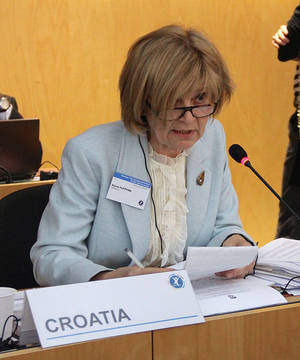|
23.04.2014
Download press release | PDF475KBSnapshots of Croatia at Convention-related activities on Flickr.Zadar, Croatia and Geneva – National demining programmes are being called upon again to support integrating landmine victim assistance into broader national approaches to healthcare, disability and human rights.
The call was made at the eleventh annual Mine Action Symposium in Zadar, Croatia.Photo, Office for Mine Action, Cromac.“Mine action entities can raise awareness, support or initiate national inter-ministerial processes to address the needs and guarantee the rights of landmine victims and survivors in broader contexts. This would benefit not only the survivors but all persons living with disabilities,” said Juan Carlos Ruan, a Mine Action Implementation Specialist with the Anti-Personnel Mine Ban Convention’s Geneva-based secretariat, speaking at the symposium. Croatia, which was one of the first States to join the Convention in 1998, is hosting demining specialists from several mine-affected countries. In addition to mine clearance, the Convention obliges its States Parties to assist the victims of anti-personnel mines. “In an original report produced by the Convention’s secretariat, we illustrate how mine action entities can contribute to victim assistance,” said Juan Carlos Ruan. “Five Key Examples of the Role of Mine Action in Integrating Victim Assistance into Broader Frameworks provides concrete examples of how mine action programmes have played an important supporting role in landmine victim assistance. If mine action structures play their niche role effectively, we could see further gains in victim assistance,” said Juan Carlos Ruan. The publication and its potential to help national mine action authorities, United Nations advisors and partner governments were highlighted during the symposium in Croatia. It was noted, for instance, that age- and sex-disaggregated data on mine and other explosive remnants of war casualties collected by mine action programmes can be fed into broader national injury surveillance and disability information systems.
“Lead responsibilities for landmine victim assistance should rest in ministries with responsibilities for social affairs, health, labour and education and with national disability councils and human rights organs,” said Dijana Plestina, Director of Croatia’s national mine action authority. Photo, archive“Nevertheless, mine action authorities can promote effective coordination between landmine survivors and their representative organisations, those interested in assisting them, and relevant state entities,” added Dijana Plestina. Five Key Examples of the Role of Mine Action in Integrating Victim Assistance into Broader Frameworks can be downloaded from here. The 1997 Anti-Personnel Mine Ban Convention was the first disarmament instrument to take into consideration the rights of the survivors of a particular weapon. Since entering into force, millions of square metres of once dangerous lands have been released for normal human activity and over 45.7 million stockpiled mines have been destroyed. For press inquiries, contact: Laila Rodriguez press(at)apminebanconvention.org, +41 (0) 22 730 9350. Find the Convention on Facebook, Flickr and Twitter. |



